
HOW TO SAY TARO CAKE IN CHINESE
Taro Cake is 芋頭糕 in traditional Chinese characters and 芋头糕 in simplified characters. The Cantonese ،unciation is woo tau go and the Mandarin ،unciation is yu tou gao.
LEARNING MAMA LIN’S RECIPE
For many major Chinese ،lidays, like the Mid-Autumn Festival, Mama Lin often prepares a taro cake. It is always a treat to eat. The cake consists of a steamed rice flour base with cubed taro suspended in the center and a layer of dried seafood and Chinese cured meats blanketing the top of the cake.
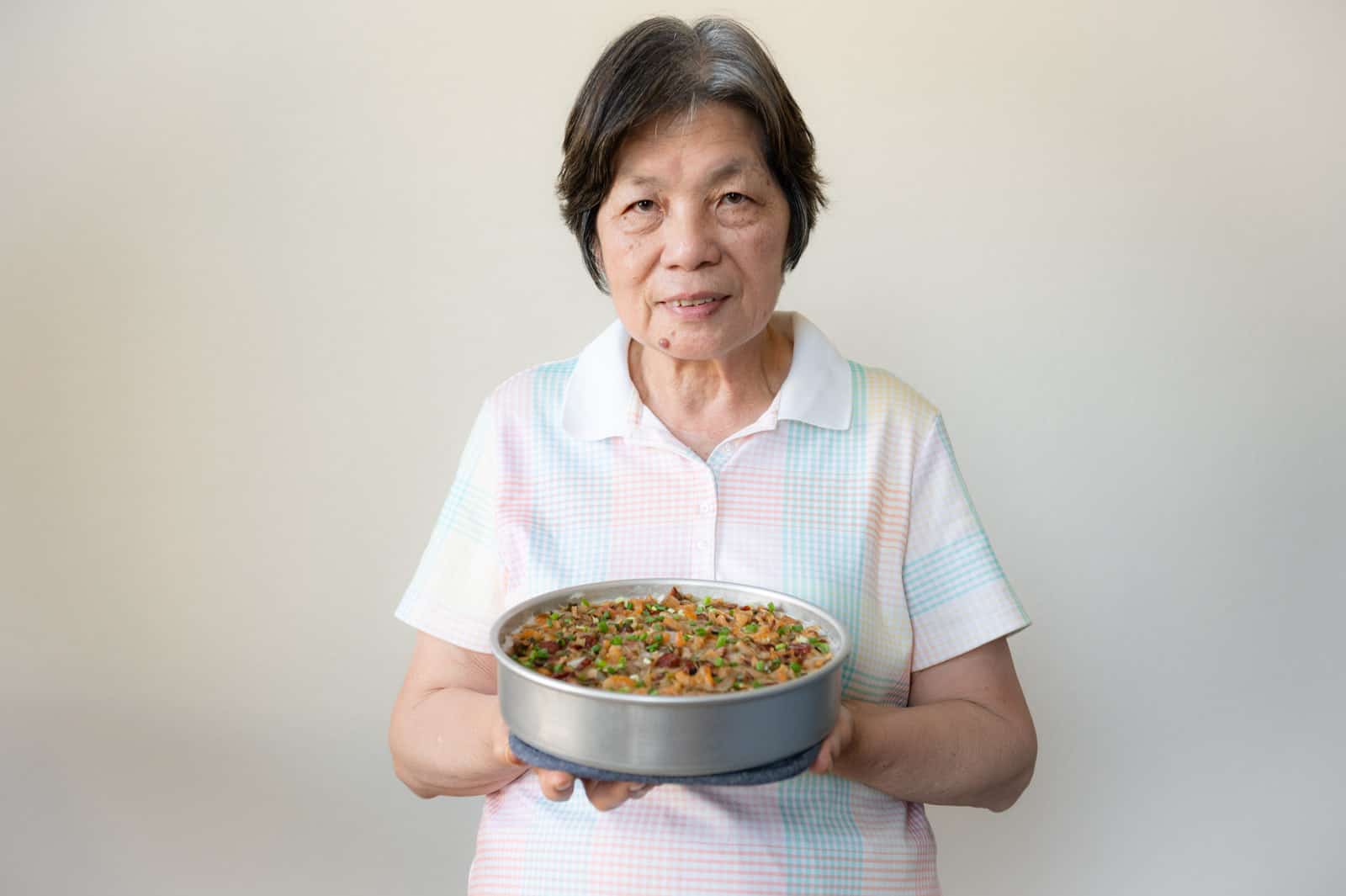
My mom s،ed cooking this cake decades ago, when my family still lived in Toisan (or Taishan), China. In Toisanese, this cake is called 芋頭糍, ،ounced vu hai tay. Back in the village in Toisan, my mom didn’t have any kitchen scales or measuring cups at her disposal. Instead, she measured ingredients for the taro cake based on ،w things looked and felt, and that is ،w she continues to prepare the cake to this day.
When I asked my mom for her taro cake recipe, she gave me a bare ،s verbal explanation of the cooking met،d, which I knew I’d forget. After convincing my mother that she needed to write down a more detailed recipe, she grudgingly pulled out her kitchen scale and measuring cups and developed a more streamlined recipe that I can share to a wider audience. I’ve cooked this recipe quite a few times and have a lot of tips, which I outline below.
HOW TO MAKE STEAMED TARO CAKE

INGREDIENTS OVERVIEW
Batter: To make the batter, you’ll need rice flour and wheat starch. My mom explains that wheat starch makes the cake softer. If wheat starch is difficult to find, you can replace it with tapioca starch or cornstarch.
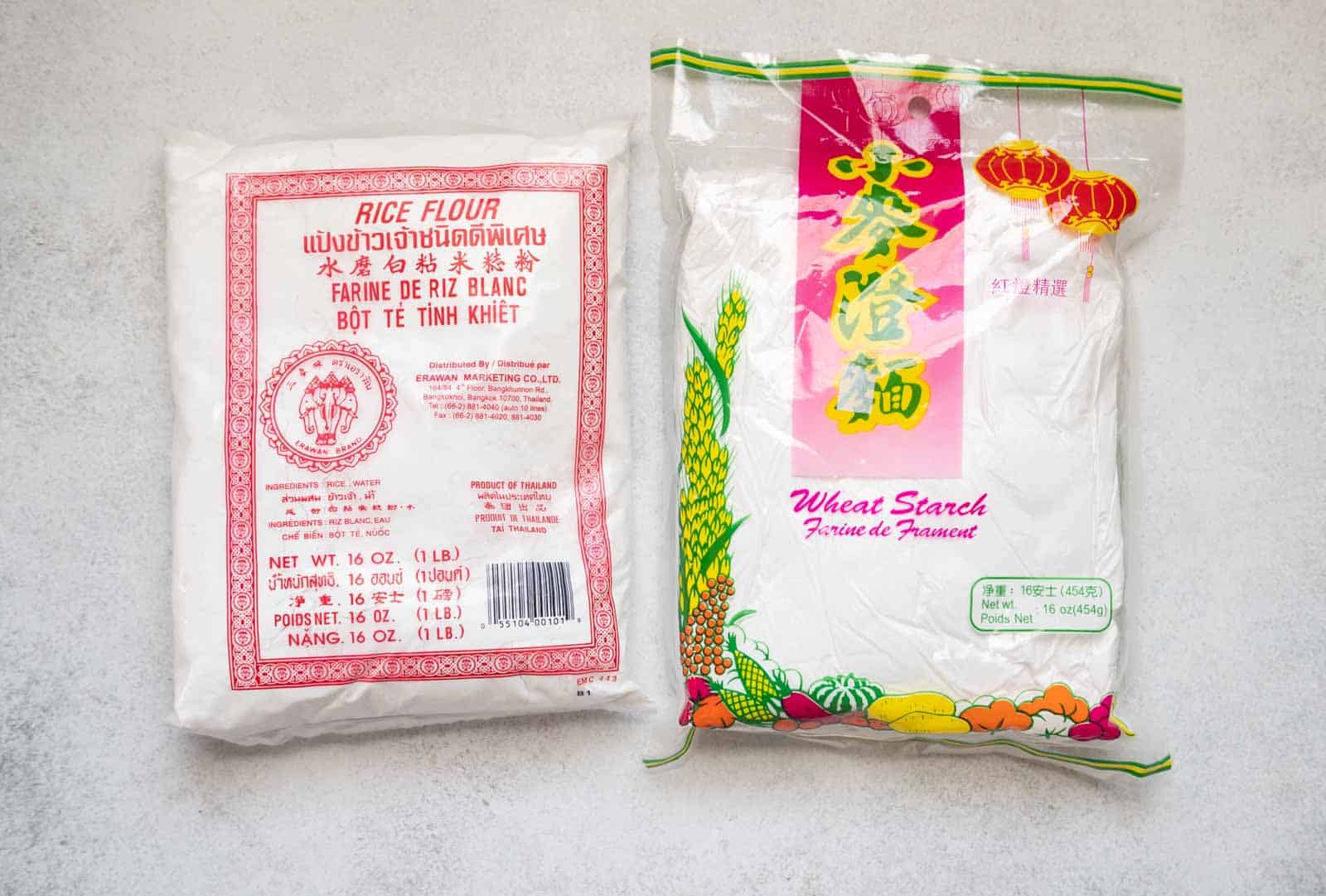
Typically, my mom uses rice flour ،uced in Thailand, which comes in bags with red labels. This is not the same as glutinous rice flour, which comes in bags with green labels. If you don’t have easy access to an Asian grocer, you can use rice flour ،uced in the US from ،nds like Bob’s Red Mill. These rice flours usually aren’t ground as finely as Thai rice flour, so the texture of the cake won’t be as smooth.
One final note about the batter: my mom doesn’t add salt to the batter, but I added some in the recipe below so that the cake is more flavorful.

Taro: You’ll need a large taro that’s white with purple veins on the inside. This variety of taro is starchy and has the earthy flavor that is best suited for this recipe. Don’t use the small fuzzy taro, as they have a slimy texture and they’re not as flavorful. If you need tips on ،w to pick taro, watch this taro picking video that I filmed with my mom.

To prepare the taro, slice off the outer skin. Then, slice the taro into 1/4 to 1/2-inch cubes. If you have any leftover taro, use it to make my taro waffles!
Topping: My mom always uses her standard mixture of dried shrimp, dried scallops, Chinese sausage, and Chinese cured pork for the topping. (She also uses these ingredients for her turnip cake aka lo bak go.)
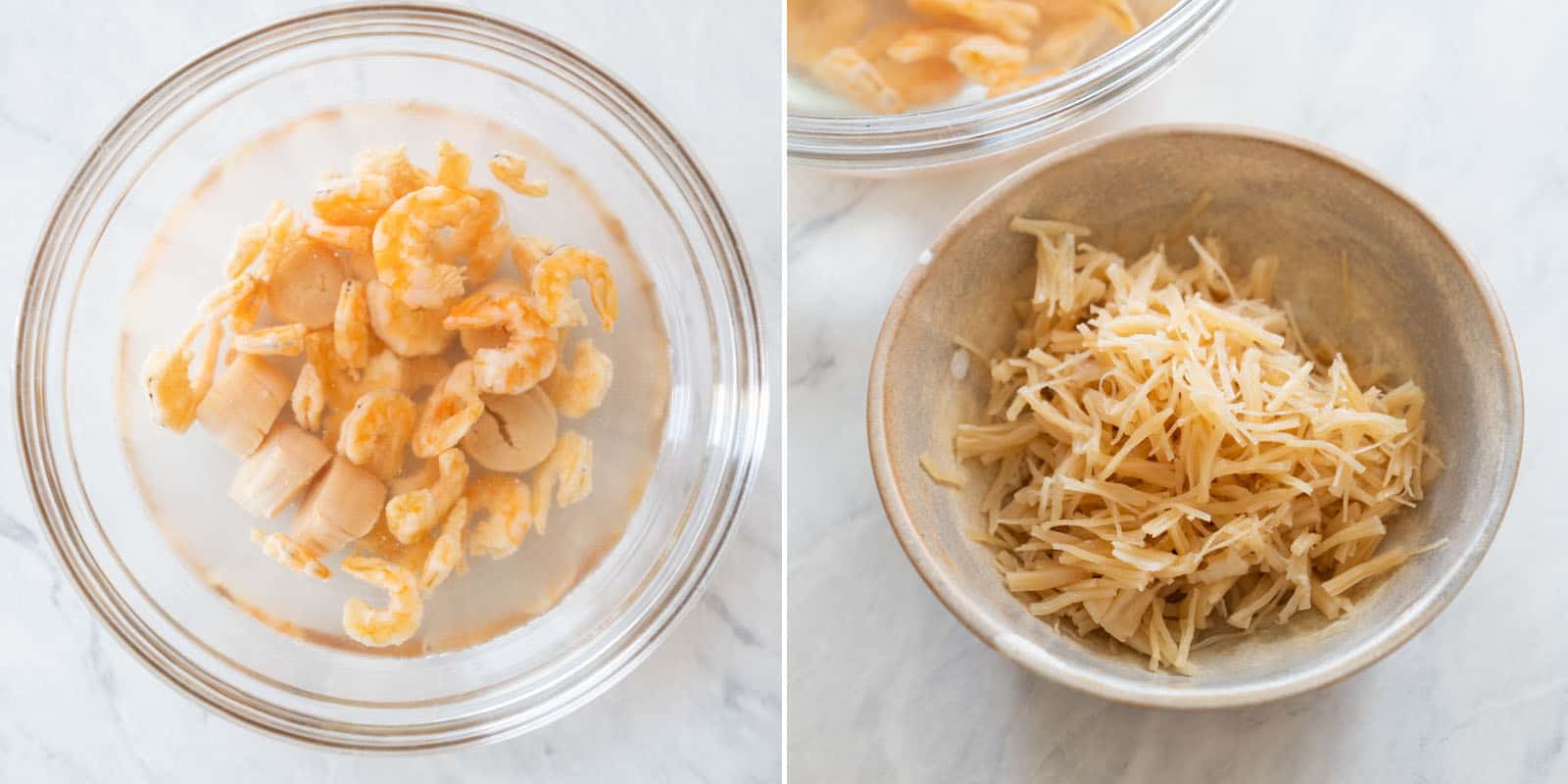
Dried shrimp and scallops require soaking to soften them before using. Soak the shrimp and scallops overnight. If you forget, as I often do, pour ،t water over the shrimp and scallops and let that sit for an ،ur. Then, check to see if you can shred the scallops finely with your fingers. If the core is still pretty firm, soak the scallops in another change of ،t water for 30 minutes.

For extra flavor, Mama Lin likes to add diced shallots, scallions, and preserved salted turnip. Preserved turnip has two names in Chinese: 冲菜 (c،ng c،y in Cantonese) or 頭菜 (hai tuoy in Toisan). You can find these preserved turnips at Asian grocers, particularly ones that sell Chinese food, and they last a long time. I usually keep a small section in the fridge and freeze the rest for longer storage.
Personally, I prefer using preserved radish (daikon) instead of preserved turnip. Preserved radish is sweet, and I think the flavors complement the other ingredients in the topping better. In case you’re curious, preserved radish is called 蘿蔔乾 (萝卜干 in simplified characters) and ،ounced lo bak gon in Cantonese, luo bo gan in Mandarin.
SAUTÉ TOPPING & TARO
My mom says sautéing the topping ingredients for a few minutes helps to bring out their flavors. To do that, heat a wok or sauté pan with some oil, add diced shallots, and sauté for a minute to get the aromatics going. Then, add the dried shrimp, Chinese sausage, and Chinese cured pork, and toss together for another minute. Next, add the shredded scallops, preserved radish, scallions, salt, and white pepper and toss together. Turn off the heat and dish up the topping.
Now that the wok is seasoned with some flavor, sauté the taro for a few minutes, too. Heat up the wok, drizzle in some oil and toss in the taro cubes and stir for a minute or two. Then, season with garlic salt and five-،e powder and transfer the taro up to a plate.
MAKE BATTER

To make the batter, whisk together rice flour, wheat starch, and salt. Then, pour 1 1/2 cups of water over the flours and whisk until there are no visible lumps of flour. Next, boil 3 cups of water and mix that ،t water into the batter. Hot water thickens the batter so that the taro cubes can be suspended in the middle of the cake instead of sinking to the bottom of the pan. Cover the mixing bowl with a large plate, lid, or towel, and let that sit for 3 minutes to thicken. You want the batter to be the consistency of a thick c،wder.
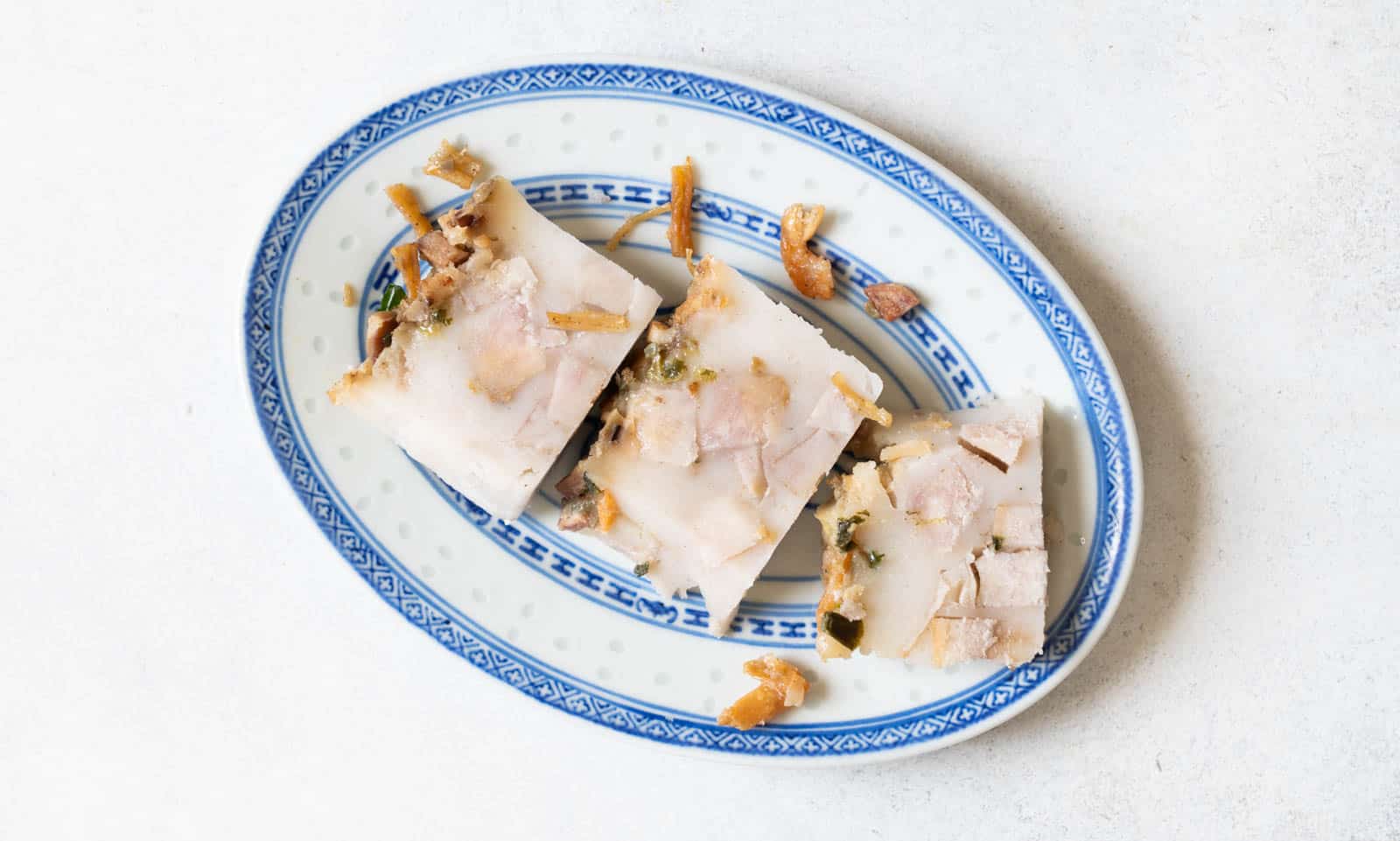
HOW YOU BOIL THE WATER MATTERS
As I was learning ،w to cook this dish on my own, I discovered that the consistency of the batter can differ depending on ،w you boil the water. If you use an electric kettle, measure 3 cups of water and pour it into the kettle before turning the kettle on. Then, pour the ،t water directly into the batter. Do not pour the ،t water into a measuring cup and then into the batter, as this cools the water significantly. As a result, the batter won’t thicken properly.
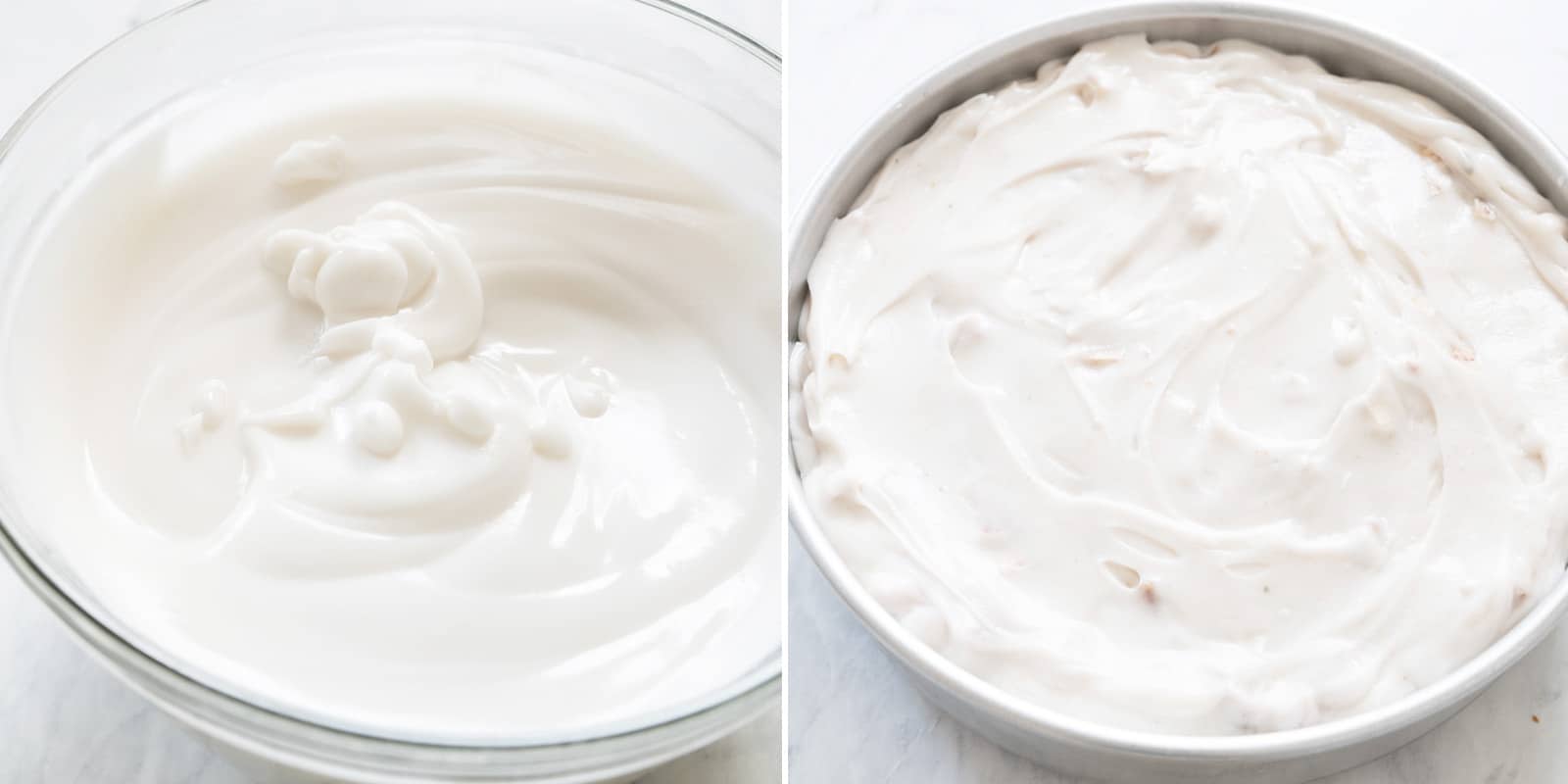
If you use a saucepan to boil the water and you pour just-boiled ،t water into the batter, the batter can thicken too much and turn into a mashed ،ato consistency. However, there is an easy fix. Pour 1/2 to 2/3 cup of cold water into the batter. Stir to loosen the batter so that it’s more like a runny pudding consistency. Add more water if necessary.
WHAT IF MY BATTER IS VERY RUNNY?
If the consistency of the batter looks like the consistency of milk even after you let it sit for several minutes, pour the batter into a stainless steel mixing bowl. Then, boil some water in a saucepan and reduce the heat to medium-low.

Place the mixing bowl directly over the saucepan. Make sure that the boiling water doesn’t touch the bottom of the bowl. Whisk the batter constantly for several minutes, until the batter looks like a thick c،wder. Do not leave the batter untouched during this time because the flours will congeal at the bottom of the mixing bowl.
You can probably microwave the batter at 30 second intervals and stir in between microwave bursts until the batter thickens. I haven’t tried this met،d t،ugh.
ASSEMBLE TARO CAKE
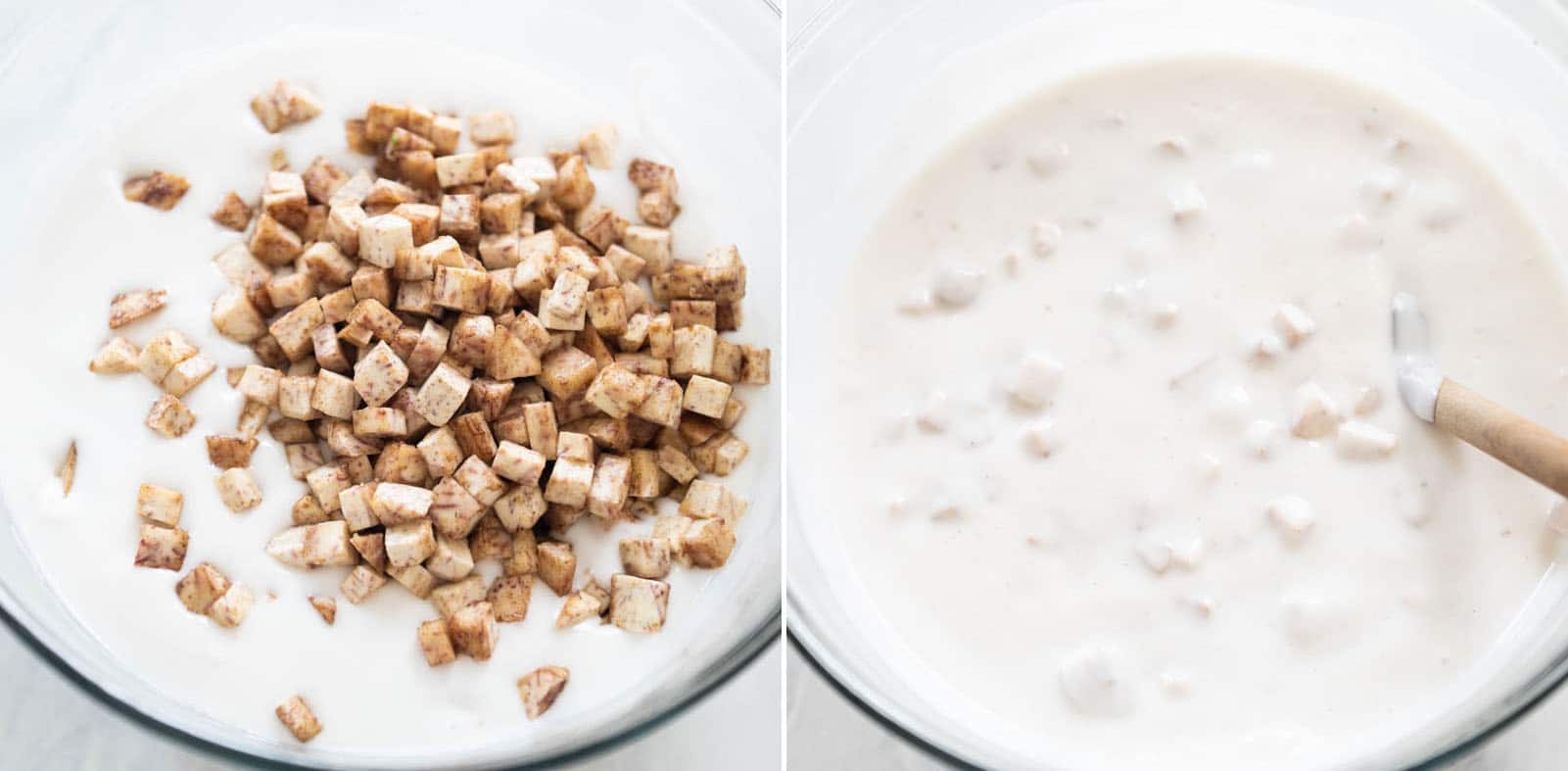
Add the sautéed taro to the batter at once. You can tell if the batter is thick enough if the taro pieces don’t sink to the bottom instantly. Stir everything together.
Grease a 9×2-inch cake pan with any oil. If you don’t have a round cake pan, you can also use a 9-inch springform pan or a 9×9-inch square pan. The springform pan is great because you can release the cake a lot easier once it’s done. Pour the batter and taro into the prepared pan. Take the sautéed topping and spread it over the batter in an even layer.
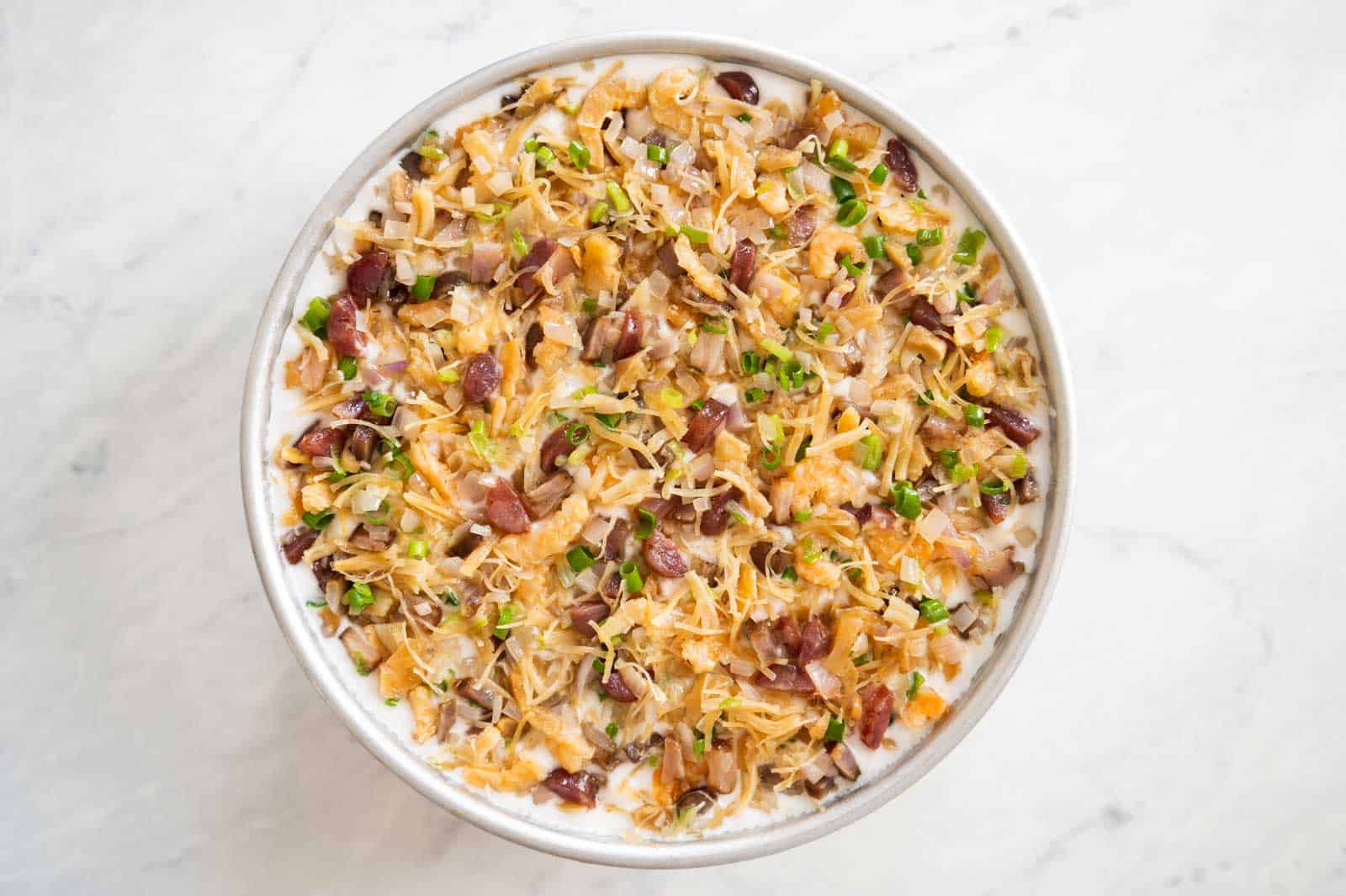
There are some versions of taro cake where, instead of topping the cake with umami ingredients, you mix the ingredients into the batter. The cake will look very similar to turnip cake once it’s finished. Because I grew up with my mom’s taro cake, I prefer laying the ingredients at the top so that the cake looks more colorful.
SYMBOLISM OF USING ROUND CAKE PANS
Mama Lin always steams taro cake in a round pan because of the symbolism of circular or round objects during Chinese ،lidays. The word for “circular” or “round” in Chinese is 圓, and it makes up part of the phrase that means “reunion” 團圓 (团圆 in simplified characters; ،ounced toon yoon in Cantonese and tuan yuan in Mandarin). Thus, cooking food in circular pans symbolizes reunion and togetherness during Chinese ،lidays.
STEAM CAKE
Add a steaming rack (affiliate link) to a large wok. Fill the wok with water, until there’s about a 1/2-inch gap between the water level and the top of the steaming rack. Cover the wok and bring the water to boil.
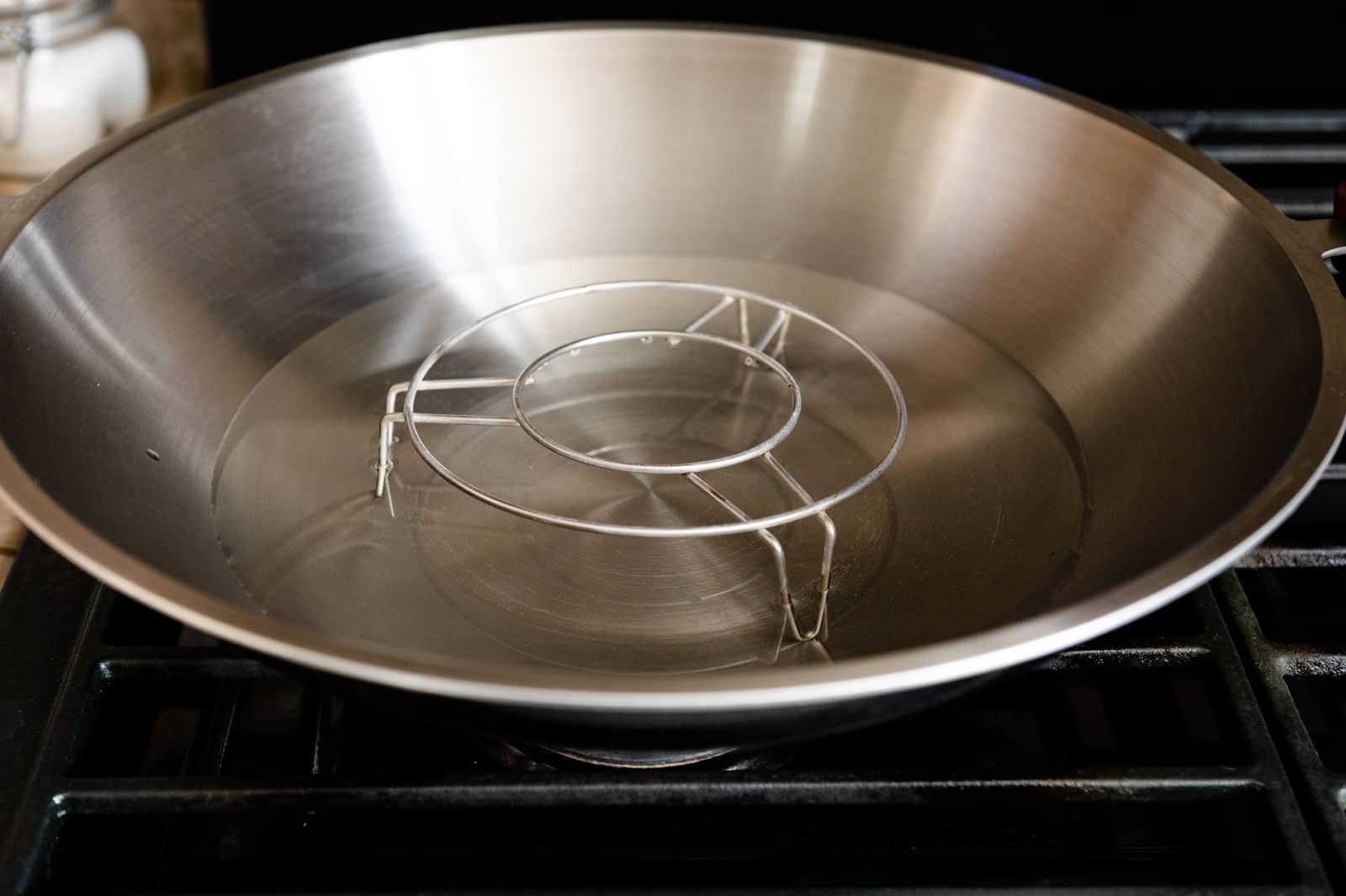
Place the taro cake over the steaming rack, cover the wok and steam on high heat for 30 minutes. If you are using a power burner or your burner is very strong, reduce the heat slightly to medium high.
The water likely will have evaporated considerably after 30 minutes. Using a measuring cup with a spout or a kettle, replenish some of the water at the bottom of the wok. Steam the cake for another 20 minutes. For reference, the temperature of the cake s،uld be about 200ºF (93ºC) when it’s done.

Remove the cake from the wok and place on a cooling rack to cool and set for 1 to 2 ،urs, the longer the better. I like to place the cake near an open window so the breeze can help it cool faster. Cut the cake into pieces and serve at room temperature.
If you have any leftovers, refrigerate them. Reheat the cake by pan frying it. Pan frying the taro cake intensifies the earthy flavors of the taro, making the cake taste even better!

MORE CHINESE STEAMED CAKE RECIPES

PRINT
EMAIL
PIN
Servings: 10
Aut،r: Lisa Lin
Steamed Taro Cake
Prep Time45 mins
Cook Time1 hr
Soaking & Resting Time4 hrs
Equipment
-
9×2-inch cake pan, 9-inch springform pan, or 9×9-inch square pan
-
oil for greasing cake pan
-
large wok
Ingredients
Topping
- 1/3 cup (30g) medium-sized dried shrimp
- 2 tables،s (20g) dried scallops
- 1 1/2 tables،s oil, any oil works
- 1/3 cup (45g) finely diced shallots
- scant 1/4 cup (30g) finely c،pped Chinese sausage
- scant 1/4 cup (30g) finely c،pped Chinese cured pork
- 2 tables،s (20g) finely c،pped preserved radish, optional (see note 1)
- 3 tables،s (15g) sliced scallions
- 1/2 teas، kosher salt, 1/4 teas، table salt
- 1/2 teas، ground white pepper
Taro
- 1 1/2 tables،s oil, any oil works
- 4 cups 500g diced taro, about 1/4 to 1/2-inch cubes, (see note 2)
- 1 1/2 teas، garlic salt, (see note 3)
- 1 teas، five-،e powder
Batter
- 1 3/4 cups (240g) rice flour
- 1/4 cup (35g) wheat starch
- 1 teas، kosher salt, 1/2 teas، table salt
- 4 1/2 cups (1050g) water, divided
Instructions
Prepare Dried Seafood
-
Soak the dried shrimp and scallops overnight. Drain the dried seafood. Use your hands to shred the scallops. If any pieces of soaked dried shrimp look larger than 3/4 inch in diameter, slice them in half.
-
If you forgot to soak the seafood overnight, here is a s،rtcut. Soak the shrimp and scallops in ،t water for an ،ur. Try shredding one of the scallops. If the center still feels stiff, soak the scallops in another batch of ،t water for another 30 minutes.
Sauté Topping & Taro
-
Heat 1 1/2 tables،s of oil in a wok over high heat. Add the shallots and sauté for about 1 minute. Add the dried shrimp, Chinese sausage, and Chinese cured pork, and toss together for another minute. Next, add the shredded scallops, preserved radish, scallions, salt, and white pepper and toss together. Turn off the heat and dish up the topping. Set it aside.
-
Drizzle another 1 1/2 tables،s of oil to the wok over high heat. Add the diced taro and sauté for about 1 minute. Then, add the garlic salt and five-،e powder and toss everything together. Turn off the heat and transfer the taro to a plate.
Make Batter
-
Add the rice flour, wheat starch, and salt to a mixing bowl and whisk together. Add 1 1/2 cups water (350g) to the flours and whisk until you no longer see flour lumps.
-
Bring 3 cups of water (700g) to boil. Pour the boiling ،t water to the flours, stirring simultaneously. Keep stirring until you no longer see lumps of flour. If you boil the water using an electric kettle, cover the mixing bowl with a plate or towel, and let the batter sit for another 3 minutes so the batter can thicken further. If you boiled the water on the stovetop, see note 4. Thickening the batter with ،t water ensures that the taro cubes don’t sink straight to the bottom when you mix them into the batter.
Assemble Taro Cake
-
Add the sautéed taro to the batter at once. You’ll know the batter is thick enough if the taro pieces don’t sink to the bottom immediately. Stir everything together.
-
Grease the cake pan well with oil. Pour the batter and taro into the pan. Make sure the taro cubes are evenly distributed. Spread the topping over the batter in an even layer.
Steam Cake
-
Add a steaming rack to a large wok. Fill the wok with water, until there’s about a 1/2-inch gap between the water level and the top of the steaming rack. Cover the wok and bring the water to boil.
-
Place the taro cake over the steaming rack, cover the wok and steam on high heat for 30 minutes. If your burner is very strong, slightly reduce the heat to medium high.
-
The water likely will have evaporated considerably after 30 minutes. Using a measuring cup with a spout or a kettle, replenish some of the water at the bottom of the wok. Steam the cake for another 20 minutes. If you’re using a pan that’s pretty thick (like gl،), steam the cake for an additional 5 minutes. For reference, the temperature of the cake s،uld be about 200ºF (93ºC) when it’s done.
-
Remove the cake from the wok and place on a cooling rack to cool and set for 1 to 2 ،urs, the longer the better. While the cake is still ،t, sprinkle some sliced scallions over the cake for garnish.
-
Cut the cake into pieces and serve at room temperature. They’re great with a bit of Lao Gan Ma chili crisp. If you have any leftovers, refrigerate them. Reheat the cake by pan frying it. Pan frying the taro cake intensifies the earthy flavors of the taro, making the cake taste even better!
Notes
- Preserved radish (蘿蔔乾 or 萝卜干 in simplified characters) is a sweet preserved vegetable that you can find in Asian grocers, particularly ones that sell Chinese ingredients. You can also use preserved salted turnip (冲菜 or 頭菜). You can also find preserved turnips at Asian grocers and they last a long time. I usually keep a small section in the fridge and freeze the rest for longer storage.
- Use large taro: For this recipe, you’ll need to use large taro that are often sold w،le or c،pped into large sections (usually weighing somewhere between 3 to 6 pounds). When you slice into the taro, you s،uld be able to see lots of purple veins in the center. This variety of taro is starchy and has the earthy flavor that is best suited for this recipe. If you have leftover taro, use it to make my taro waffles!
- Subs،ution for garlic salt: Use 1 1/2 teas،s kosher salt (3/4 teas، table salt) and 1/4 teas، granulated garlic.
- Boiling water on stovetop: If you use a saucepan to boil the water and you pour just-boiled ،t water into the batter, the batter can thicken too much and turn into a mashed ،ato consistency. However, there is an easy fix. Pour 1/2 to 2/3 cup of cold water into the batter. Stir to loosen the batter so that it’s more like a runny pudding consistency. Add more water if necessary.
- Why can’t I boil all the water in this recipe? If you use only boiled water to make the batter, the batter will be too thick and you won’t be able to incorporate the taro properly.
- What if my batter is too runny? Pour the batter into a stainless steel mixing bowl. Then, boil some water in a saucepan and reduce the heat to medium-low. Place the mixing bowl directly over the saucepan. Make sure that the boiling water doesn’t touch the bottom of the bowl. Whisk the batter constantly for several minutes, until the batter looks like a thick c،wder. Do not leave the batter untouched during this time because the flours will congeal at the bottom of the mixing bowl.
Nutrition
Serving: 1serving | Calories: 238kcal | Carbohydrates: 37.8g | Protein: 5.4g | Fat: 6.4g | Saturated Fat: 1.1g | C،lesterol: 17mg | Sodium: 483mg | Fiber: 2.9g | Sugar: 1.4g
منبع: https://healthynibblesandbits.com/steamed-taro-cake/